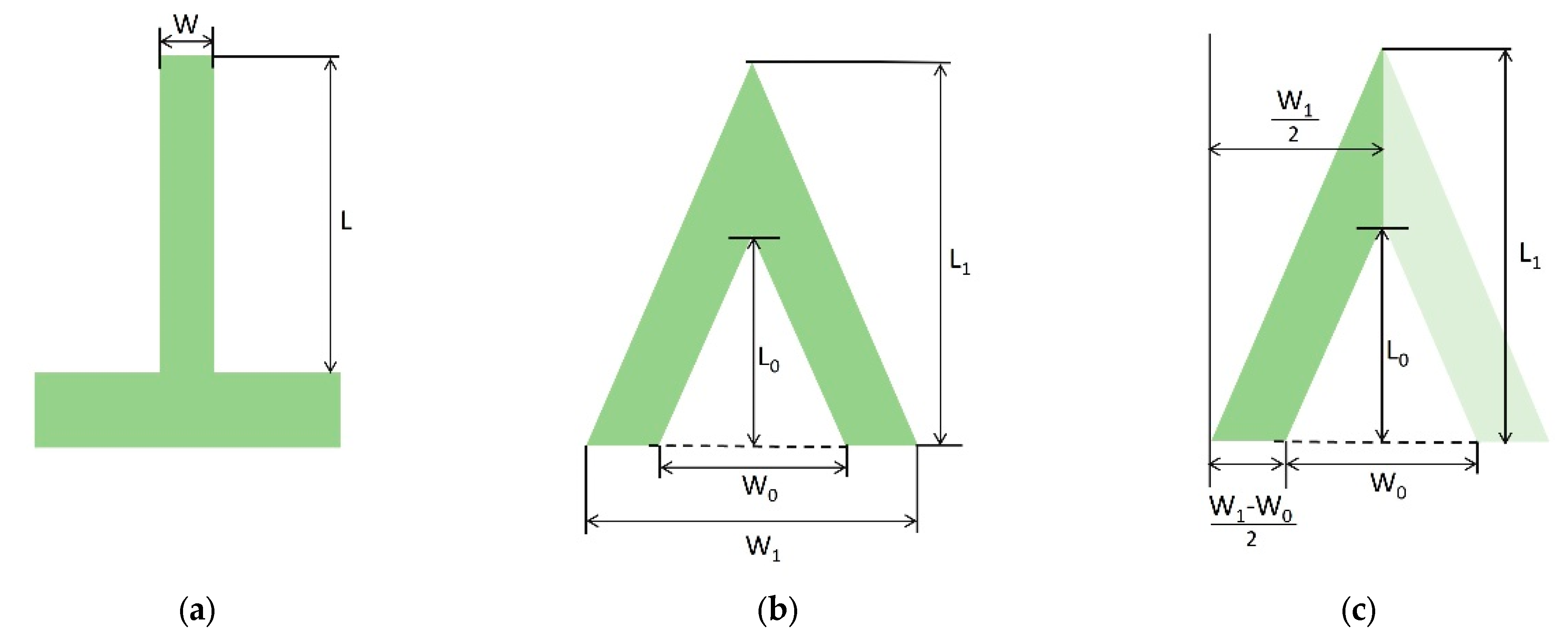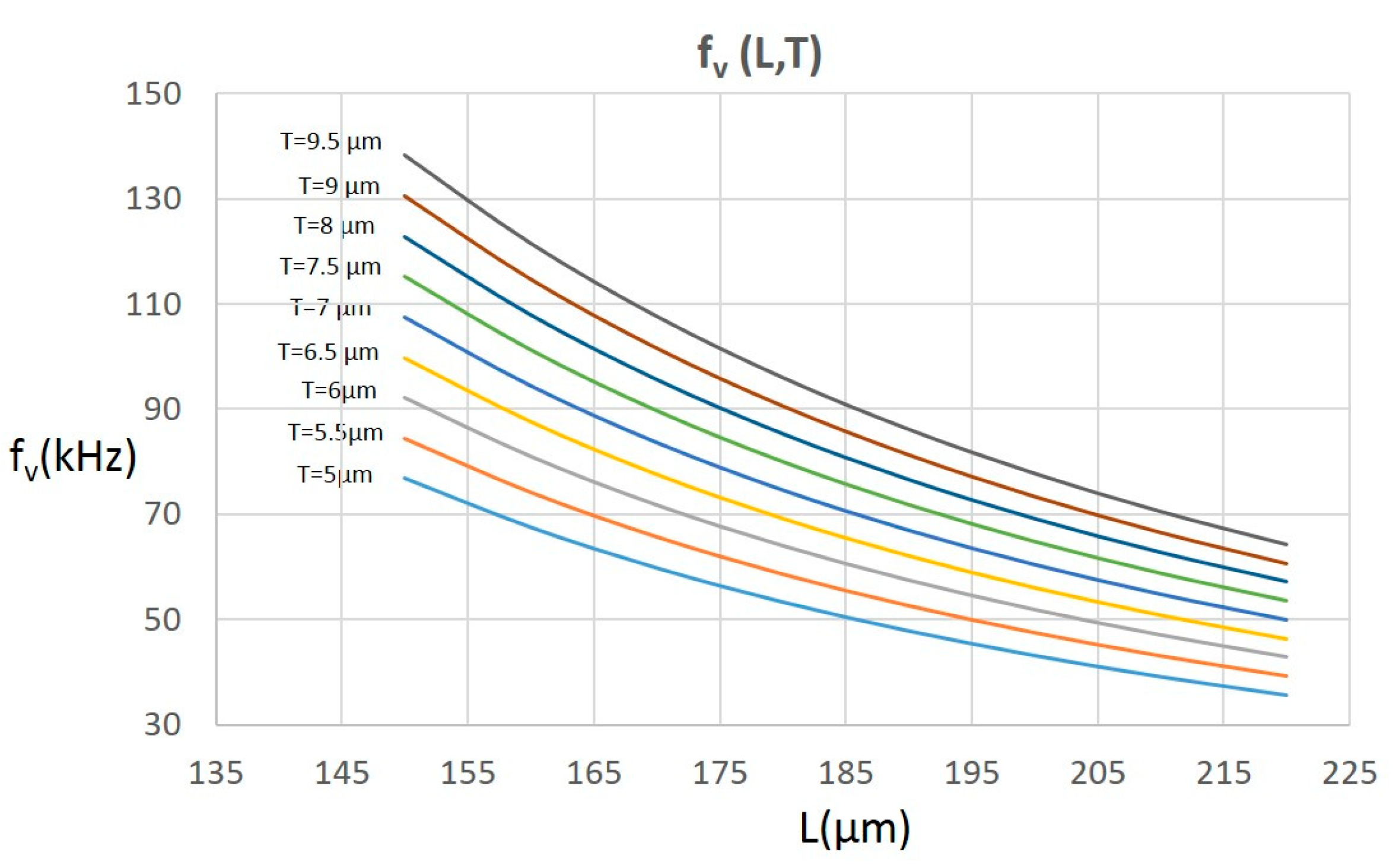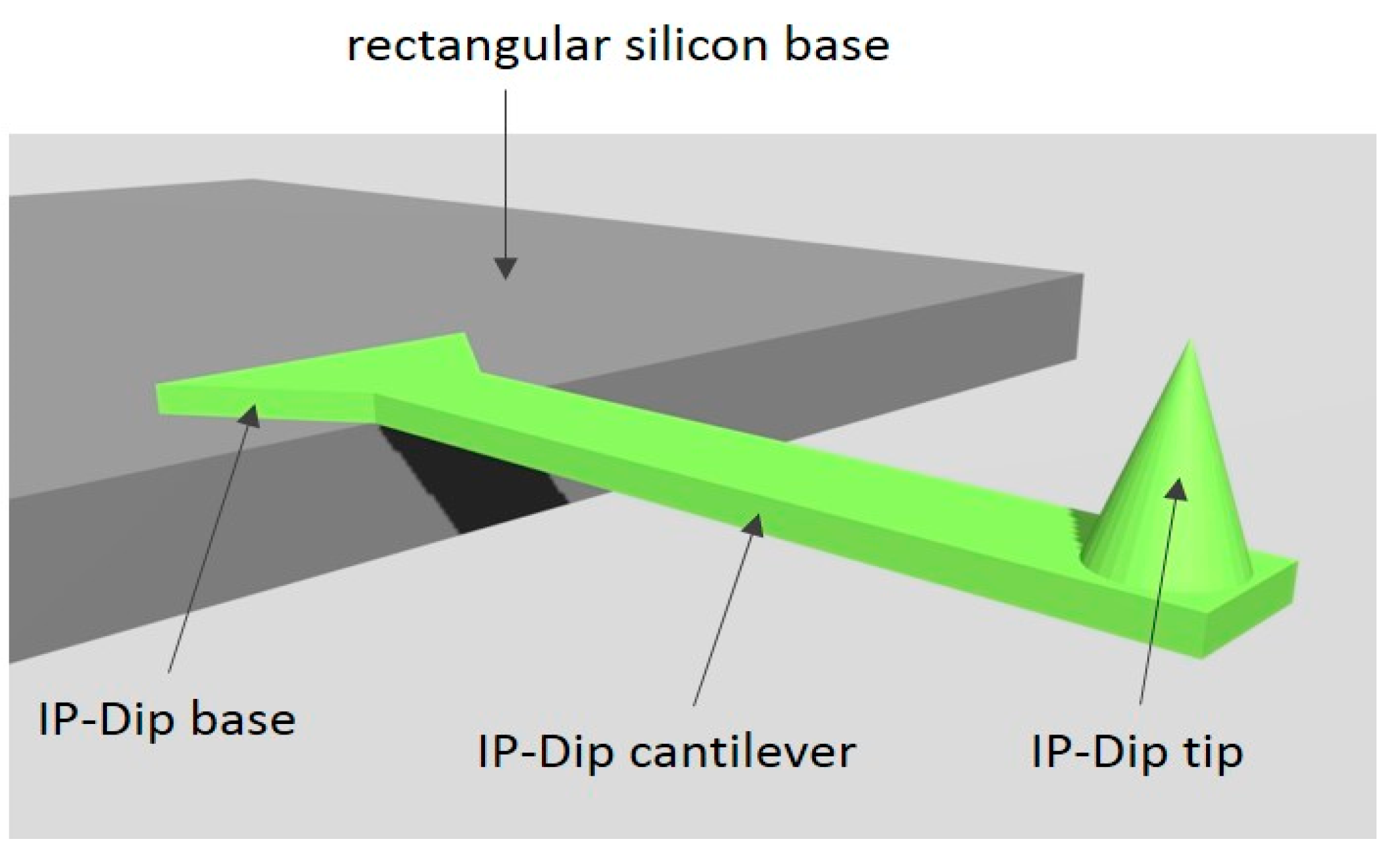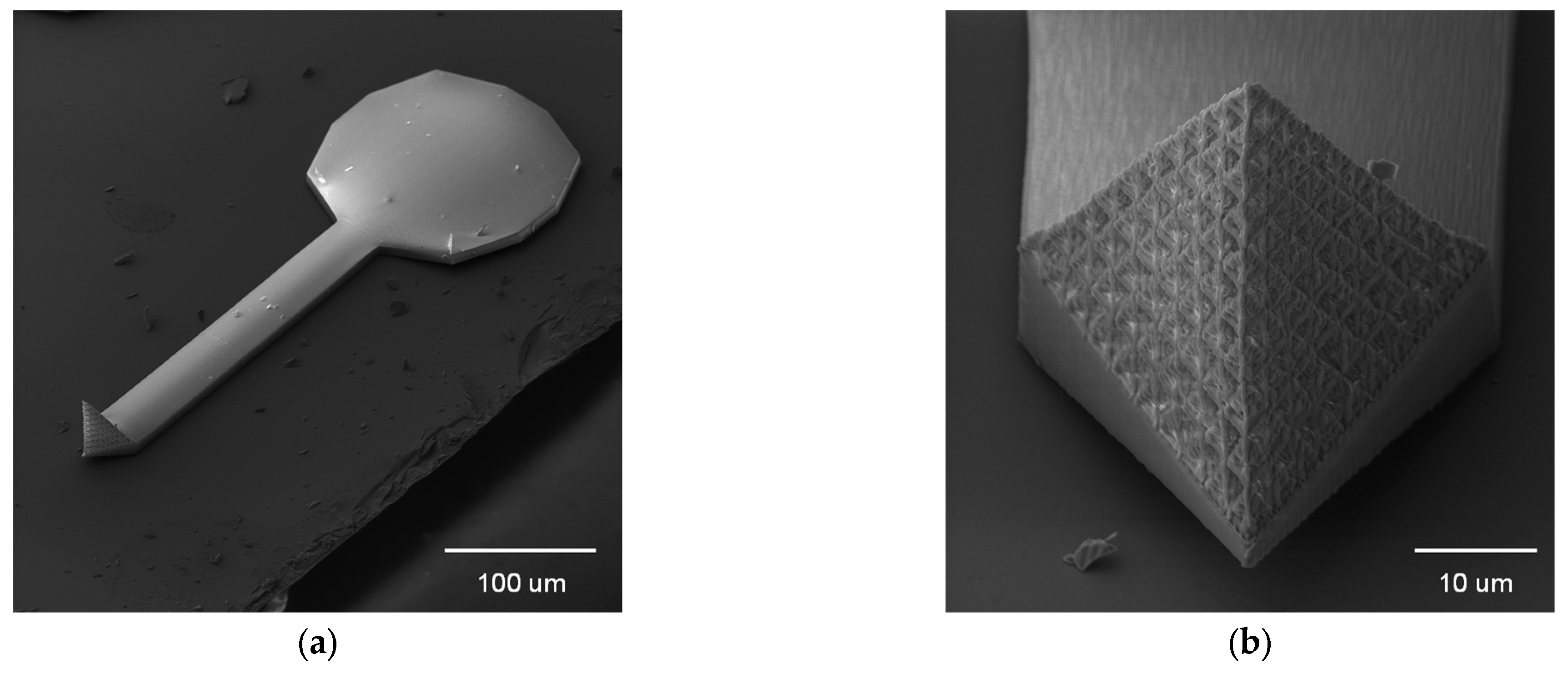Advancing Atomic Force Microscopy: Design of Innovative IP-Dip Polymer Cantilevers and Their Exemplary Fabrication via 3D Laser Microprinting
Abstract
1. Introduction
2. Geometry of Cantilevers

3. Experimental
4. Results and Discussion
5. Conclusions
Author Contributions
Funding
Institutional Review Board Statement
Informed Consent Statement
Data Availability Statement
Conflicts of Interest
References
- Méndez-Vilas, A.; González-Martín, M.; Nuevo, M. Optical Interference Artifacts in Contact Atomic Force Microscopy Images. Ultramicroscopy 2002, 92, 243–250. [Google Scholar] [CrossRef] [PubMed]
- You, H.; Yu, L. Investigation of the Image Contrast of Tapping-Mode Atomic Force Microscopy Using Protein-Modified Cantilever Tips. Biophys. J. 1997, 73, 3299–3308. [Google Scholar] [CrossRef] [PubMed]
- Sedin, D.L.; Rowlen, K.L. Influence of Tip Size on AFM Roughness Measurements. Appl. Surf. Sci. 2001, 182, 40–48. [Google Scholar] [CrossRef]
- Sader, J.E.; Chon, J.W.M.; Mulvaney, P. Calibration of Rectangular Atomic Force Microscope Cantilevers. Rev. Sci. Instrum. 1999, 70, 3967–3969. [Google Scholar] [CrossRef]
- Siedle, P.; Butt, H.-J.; Bamberg, B.; Wang, D.N.; Kühlbrandt, W.; Zach, J.; Haider, M. Determining the Form of Atomic Force Microscope Tips. In X-Ray Optics and Microanalysis 1992, Proceedings of the 13th INT Conference, Manchester, UK, 31 August–4 September 1992; CRC Press: Boca Raton, FL, USA, 1993; ISBN 978-1-00-306296-7. [Google Scholar]
- Ke, S.H.; Uda, T.; Štich, I.; Terakura, K. Effect of Tip Morphology on AFM Images. Appl. Phys. A 2001, 72, S63–S66. [Google Scholar] [CrossRef]
- Grow, R.J.; Minne, S.C.; Manalis, S.R.; Quate, C.F. Silicon Nitride Cantilevers with Oxidation-Sharpened Silicon Tips for Atomic Force Microscopy. J. Microelectromechanical Syst. 2002, 11, 317–321. [Google Scholar] [CrossRef]
- Kulisch, W.; Malave, A.; Lippold, G.; Scholz, W.; Mihalcea, C.; Oesterschulze, E. Fabrication of Integrated Diamond Cantilevers with Tips for SPM Applications. Diam. Relat. Mater. 1997, 6, 906–911. [Google Scholar] [CrossRef]
- Hantschel, T.; Slesazeck, S.; Niedermann, P.; Eyben, P.; Vandervorst, W. Integrating Diamond Pyramids into Metal Cantilevers and Using Them as Electrical AFM Probes. Microelectron. Eng. 2001, 57–58, 749–754. [Google Scholar] [CrossRef]
- Salvadori, M.C.; Fritz, M.C.; Carraro, C.; Maboudian, R.; Monteiro, O.R.; Brown, I.G. Characterization of AFM Cantilevers Coated with Diamond-like Carbon. Diam. Relat. Mater. 2001, 10, 2190–2194. [Google Scholar] [CrossRef]
- Givargizov, E.I.; Stepanova, A.N.; Mashkova, E.S.; Molchanov, V.A.; Shi, F.; Hudek, P.; Rangelow, I.W. Ultrasharp Diamond-Coated Silicon Tips for Scanning-Probe Devices. Microelectron. Eng. 1998, 41–42, 499–502. [Google Scholar] [CrossRef]
- Sorensen, A.H.; Hvid, U.; Mortensen, M.W.; Morch, K.A. Preparation of Platinum/Iridium Scanning Probe Microscopy Tips. Rev. Sci. Instrum. 1999, 70, 3059–3067. [Google Scholar] [CrossRef][Green Version]
- Akiyama, T.; Staufer, U.; de Rooij, N.F.; Howald, L.; Scandella, L. Lithographically Defined Polymer Tips for Quartz Tuning Fork Based Scanning Force Microscopes. Microelectron. Eng. 2001, 57–58, 769–773. [Google Scholar] [CrossRef]
- Göring, G.; Dietrich, P.-I.; Blaicher, M.; Sharma, S.; Korvink, J.G.; Schimmel, T.; Koos, C.; Hölscher, H. Tailored Probes for Atomic Force Microscopy Fabricated by Two-Photon Polymerization. Appl. Phys. Lett. 2016, 109, 063101. [Google Scholar] [CrossRef]
- Alsharif, N.; Burkatovsky, A.; Lissandrello, C.; Jones, K.M.; White, A.E.; Brown, K.A. Design and Realization of 3D Printed AFM Probes. Small 2018, 14, e1800162. [Google Scholar] [CrossRef] [PubMed]
- Kim, J.M.; Muramatsu, H. Two-Photon Photopolymerized Tips for Adhesion-Free Scanning-Probe Microscopy. Nano Lett. 2005, 5, 309–314. [Google Scholar] [CrossRef] [PubMed]
- Kim, W.-S.; Park, K.-M.; Park, J.J.; Chang, S.-M.; Kim, I.-H.; Muramatsu, H.; Kim, J.M. Polymer Tips for Application of Atomic Force Microscopy. Curr. Appl. Phys. 2007, 7, 528–531. [Google Scholar] [CrossRef]
- Yasumura, K.Y.; Stowe, T.D.; Chow, E.M.; Pfafman, T.; Kenny, T.W.; Stipe, B.C.; Rugar, D. Quality Factors in Micron- and Submicron-Thick Cantilevers. J. Microelectromechanical Syst. 2000, 9, 117–125. [Google Scholar] [CrossRef]
- Tortonese, M. Cantilevers and Tips for Atomic Force Microscopy. IEEE Eng. Med. Biol. Mag. 1997, 16, 28–33. [Google Scholar] [CrossRef]
- Neumeister, J.M.; Ducker, W.A. Lateral, Normal, and Longitudinal Spring Constants of Atomic Force Microscopy Cantilevers. Rev. Sci. Instrum. 1994, 65, 2527–2531. [Google Scholar] [CrossRef]
- Hazel, J.L.; Tsukruk, V.V. Spring Constants of Composite Ceramic/Gold Cantilevers for Scanning Probe Microscopy. Thin Solid Film. 1999, 339, 249–257. [Google Scholar] [CrossRef]
- Lemma, E.D.; Rizzi, F.; Dattoma, T.; Spagnolo, B.; Sileo, L.; Qualtieri, A.; De Vittorio, M.; Pisanello, F. Mechanical Properties Tunability of Three-Dimensional Polymeric Structures in Two-Photon Lithography. IEEE Trans. Nanotechnol. 2016, 16, 23–31. [Google Scholar] [CrossRef]
- Efimov, T.A.; Rassolov, E.A.; Andryukov, B.G.; Zaporozhets, T.S.; Romashko, R.V. Calculation of Resonant Frequencies of Silicon AFM Cantilevers. J. Phys. Conf. Ser. 2020, 1439, 012006. [Google Scholar] [CrossRef]
- Durisova, J.; Pudis, D.; Goraus, M.; Gaso, P. IP-Dip Photoresist Surfaces for Photonic Applications Prepared by Laser Lithography and Studied by AFM. Appl. Surf. Sci. 2018, 461, 108–112. [Google Scholar] [CrossRef]
- Goraus, M.; Martincek, I. Optimalisation of 3D Laser Printing Process for Highly Reflective Polymer Surfaces. In Proceedings of the 22nd Polish-Slovak-Czech Optical Conference on Wave and Quantum Aspects of Contemporary Optics, Wojanow, Poland, 5–9 September 2022; SPIE: Bellingham, WA, USA, 2022; Volume 12502, pp. 117–120. [Google Scholar] [CrossRef]
- Micek, P.; Pudis, D.; Gaso, P.; Durisova, J.; Jandura, D. Microring Zone Structure for Near-Field Probes. Coatings 2021, 11, 1363. [Google Scholar] [CrossRef]
- Suslik, L.; Gaso, P.; Jandura, D.; Pudis, D. 3D Photonic Structures for Optoelectronic Applications. In Proceedings of the 22nd Polish-Slovak-Czech Optical Conference on Wave and Quantum Aspects of Contemporary Optics, Wojanow, Poland, 5–9 September 2022; SPIE: Bellingham, WA, USA, 2022; Volume 12502, pp. 112–116. [Google Scholar] [CrossRef]
- Sun, L.; Gu, H.; Liu, X.; Ni, H.; Li, Q.; Zeng, Y.; Chang, N.; Zhang, D.; Chen, H.; Li, Z.; et al. 3D-Printed Cellular Tips for Tuning Fork Atomic Force Microscopy in Shear Mode. Nat. Commun. 2020, 11, 5732. [Google Scholar] [CrossRef] [PubMed]






Disclaimer/Publisher’s Note: The statements, opinions and data contained in all publications are solely those of the individual author(s) and contributor(s) and not of MDPI and/or the editor(s). MDPI and/or the editor(s) disclaim responsibility for any injury to people or property resulting from any ideas, methods, instructions or products referred to in the content. |
© 2024 by the authors. Licensee MDPI, Basel, Switzerland. This article is an open access article distributed under the terms and conditions of the Creative Commons Attribution (CC BY) license (https://creativecommons.org/licenses/by/4.0/).
Share and Cite
Gaso, P.; Jandura, D.; Bulatov, S.; Pudis, D.; Goraus, M. Advancing Atomic Force Microscopy: Design of Innovative IP-Dip Polymer Cantilevers and Their Exemplary Fabrication via 3D Laser Microprinting. Coatings 2024, 14, 841. https://doi.org/10.3390/coatings14070841
Gaso P, Jandura D, Bulatov S, Pudis D, Goraus M. Advancing Atomic Force Microscopy: Design of Innovative IP-Dip Polymer Cantilevers and Their Exemplary Fabrication via 3D Laser Microprinting. Coatings. 2024; 14(7):841. https://doi.org/10.3390/coatings14070841
Chicago/Turabian StyleGaso, Peter, Daniel Jandura, Sergii Bulatov, Dusan Pudis, and Matej Goraus. 2024. "Advancing Atomic Force Microscopy: Design of Innovative IP-Dip Polymer Cantilevers and Their Exemplary Fabrication via 3D Laser Microprinting" Coatings 14, no. 7: 841. https://doi.org/10.3390/coatings14070841
APA StyleGaso, P., Jandura, D., Bulatov, S., Pudis, D., & Goraus, M. (2024). Advancing Atomic Force Microscopy: Design of Innovative IP-Dip Polymer Cantilevers and Their Exemplary Fabrication via 3D Laser Microprinting. Coatings, 14(7), 841. https://doi.org/10.3390/coatings14070841





